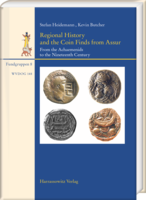|
|
more titles of the subject:
Download:
Please note: With adding digital Products to your cart
the payment will be handled via PayPal. The download will be provided after the payment is confirmed. In July 1914, the excavation of one of the most significant capitals in human history, Assur, ended successfully. After a division of finds, the objects were dispatched to Berlin on the eve of the First World War. Assur is currently the most important reference site for coin finds in northern Iraq. They constitute an independent source for the history of the settlement, the Tigris region, and for coin circulation after the fall of the Assyrian empire in 614 BC, from the Achaemenid to the late Ottoman empire. These coin finds fill an important gap in the history of Assur, whose name in the post-Assyrian period is hardly attested to. For the Arsacid period, the coin finds highlight the surprising permeability of the border from the Roman provinces to Arsacid north-eastern Mesopotamia.
With the Sasanian conquest in about 240/1, life in Assur apparently stopped. For the following 1,600 years we can distinguish at least three separate settlement phases, and almost each phase corresponds to changing names for the city. While we do not know what the settlement between the 7th and 8th century was called, in the 12th and 14th centuries it was referred to as al-'Aqr. For this period, we have more literary references to its history, at least compared with the preceding 1,800 years. The coin finds, together with the textual references, allow for an insight into the political and economic development of “a large village”. For the 17th and 18th centuries, the coins point to a revived settlement, now under the name of Qal'at Shirqat. |
|||||||||||||||||||||||||||||||||||||||






